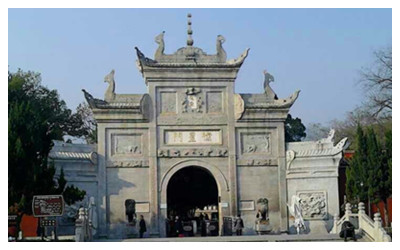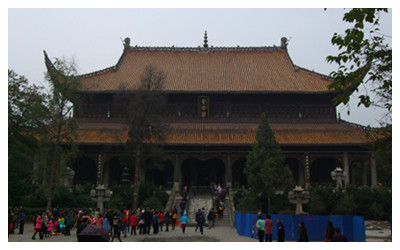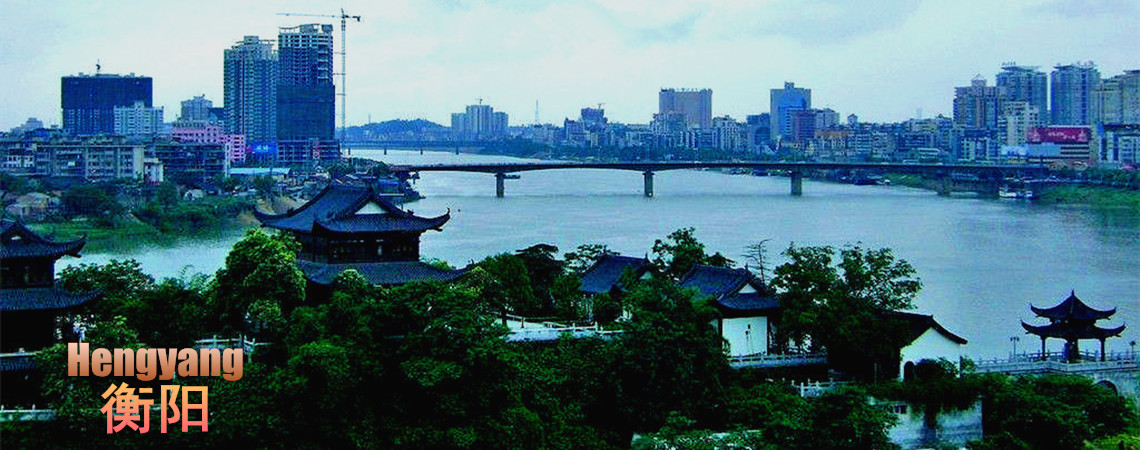- Home
- Top City Guide > Hengyang >
Nanyue Grand Temple
Imitating the style of the Forbidden City in
Beijing, Grand Temple on Hengshan Mountain showcases the coexistence of Buddhism and Taoism by a harmonious layout. The Grand Temple is renowned for its ancient building complex consisting of folk ancestral temples, Buddhist temples, Taoist temples and imperial palaces. Covering an area of 120,000 sqm, it is the largest group of ancient buildings in south China and in Five Great Mountains. It is known as “the No.1 Temple in South China” and “the Imperial Palace in South China”.
Originally built in the Sui Dynasty (581-618), the temple has been destroyed by fire for six times, and maintained and rebuilt for 17 times through the Song Dynasty (960-1279), Yuan Dynasty (1271-1368), Ming Dynasty (1368-1644) and Qing Dynasty (1644-1912). The present temple dates from the eighth year of Emperor Guangxu’s reign of the Qing Dynasty (the year of 1882). The temple was put under state protection in 2006.
 Lingxing Gate and Kuixing Pavilion
Lingxing Gate and Kuixing PavilionLingxin Gate, the entry gate to Nanyue Grand Temple, is 20 meters in height, 20 meters in width and 1.1 meters in thickness. It is the only stone entry gate of such height and width that remains in China. On each side of the gate, there are one side entrances to the Taoism temples and Buddhist temples. In the second courtyard of Nanyue Grant Temple, a stage called Kuixing Pavilion is built to deliver performance to entertain the Gods. The 2 meters high granite stage has been particularly designed and carved to amplify voices of the performers on the stage.
The Holy Emperor Hall

Built in 1880, the sixth year of Emperor Guangxu's reign (1871-1908) in Qing Dynasty, the Holy Emperor Hall is the primary hall of Nanyue GrantdTemple and the largest building in the historical Nanyue town. The Hall covers an area of 1,877 square meters. Its height is 24 meters. The 72 stone columns in this hall represent the 72 peaks scatted in Mount Hengshan. Within the Hall are pieces of fine art antiques, a treasure of the art of the state. Dragons and phoenixes were carved on the wooden eaves and door leaves. Between the 72 stone columns were 144 pieces of white marble double-sided relief sculptures, established in 1705 of Qing Dynasty. In the stage outside the hall, a white stone dragon is ready to fly. Moreover, colorful pottery on the roof and paintings on the walls along the corridor are all good examples of the elegant antique arts collections hold in this grant hall.
Travel Tips
Add: Nanyue District of Hengyang City,Hunan Province.
How to get there: Take bus from Hengyang City or Hengyang West Railway Station to Nanyue Town.
Entrance Ticket: CNY 50
Opening Hours: 08:30-18:00
When to go: The scenery can change dramatically with the seasons. Tourists can enjoy rare flowers in the spring, a sea of clouds in the summer, the beautiful sunrises in the fall, and snow-capped peaks in the winter.

 Lingxing Gate and Kuixing Pavilion
Lingxing Gate and Kuixing Pavilion Built in 1880, the sixth year of Emperor Guangxu's reign (1871-1908) in Qing Dynasty, the Holy Emperor Hall is the primary hall of Nanyue GrantdTemple and the largest building in the historical Nanyue town. The Hall covers an area of 1,877 square meters. Its height is 24 meters. The 72 stone columns in this hall represent the 72 peaks scatted in Mount Hengshan. Within the Hall are pieces of fine art antiques, a treasure of the art of the state. Dragons and phoenixes were carved on the wooden eaves and door leaves. Between the 72 stone columns were 144 pieces of white marble double-sided relief sculptures, established in 1705 of Qing Dynasty. In the stage outside the hall, a white stone dragon is ready to fly. Moreover, colorful pottery on the roof and paintings on the walls along the corridor are all good examples of the elegant antique arts collections hold in this grant hall.
Built in 1880, the sixth year of Emperor Guangxu's reign (1871-1908) in Qing Dynasty, the Holy Emperor Hall is the primary hall of Nanyue GrantdTemple and the largest building in the historical Nanyue town. The Hall covers an area of 1,877 square meters. Its height is 24 meters. The 72 stone columns in this hall represent the 72 peaks scatted in Mount Hengshan. Within the Hall are pieces of fine art antiques, a treasure of the art of the state. Dragons and phoenixes were carved on the wooden eaves and door leaves. Between the 72 stone columns were 144 pieces of white marble double-sided relief sculptures, established in 1705 of Qing Dynasty. In the stage outside the hall, a white stone dragon is ready to fly. Moreover, colorful pottery on the roof and paintings on the walls along the corridor are all good examples of the elegant antique arts collections hold in this grant hall. Ask Questions ?
Ask Questions ?